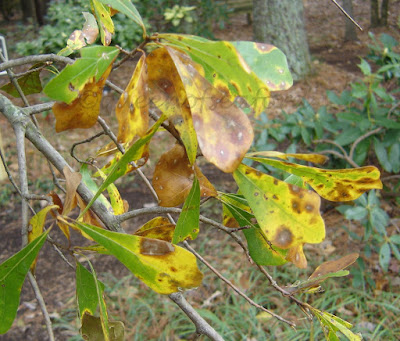This past August I traveled up and down interstate 95 and interstate 85 from DC to South Carolina and points in between. I made two trips to DC to help one daughter move into her apartment. Early in month I drove to North Carolina to help the other daughter move into her place. Along the highways I saw all sorts of interesting foliage. Trying to make an ID while driving 65+mph isn’t easy. The trip to South Carolina I didn’t drive, so I took the opportunity to look out the windows to try and figure out what plants were along the highway.
I thought that one of the plants was Sumac, Rhus glabra. Seemed there was a lot of Sumac growing along the road. Some of the plants had a flower or berries at the top. I finally figured out that must be Devil’s Walking Stick, Aralia spinosa. Both of these shrubs/trees are native to the United States. Both also form thickets of growth. I was not sure that ALL that I was seeing was in fact one or the other. Again, going down the highway is not the most effective way to make a plant ID.
Fast forward to our trip this month back to South Carolina, another opportunity to look at trees and shrubs along the drive. As we left I thought I forgot the book I was reading. Looking around the car I found a book one of my fellow Master Gardeners gave me titled Nonnative Invasive Plants of Southern Forests. I flipped through the book as we drove along.


Lo and behold, the plant of which I was trying to make identification turned out to be Tree-of-Heaven, Ailanthus altissima, an invasive nonnative. The leave pattern is pinnately compound –very similar to both Sumac and Devil’s Walking Stick. One of the key identifiers was the autumn color. Sumac turns a beautiful bronze red color as does the Devil’s Walking Stick. The Tree-of-Heaven….pale yellow. I was amazed at the thick groves of this invasive.
Sumac


Devil’s Walking Stick



see how tall it gets?
Continuing down the highway with book in hand I realized another invasive plant that is also within the National Park…Golden Bamboo, Phyliostachys aurea. It was planted as an ornamental years ago and used for fishing poles, now, it is crowding out cemeteries and homesteads as well as in ditches along the highway.
As I looked through the book there were a few more of these thugs from the book along the highway. Kudzu, Pueraria montana --we all know what it looks like. It covers everything in its wake. Skeeter did a great posting on it about a month ago at
In The Garden. My photo is from the Yorktown Battlefield. Our National Parks are being encroached upon by this and other invasives. What a nightmare these plants have become.
Last week Debbie at
Garden Thyme with the Creative Gardener wrote a great piece on other invasives. I read her posting after I got back from my trip and had decided to write something myself. There are so many plants out there that should not have been planted and now they are spreading by rhizomes, by seeds from birds or animals, by seeds on the wind…it can make a person mad!
There are so many plants that have been planted by the various highway departments that were used for erosion control or ornamental displays at the interchanges. You and I know many of them; we use them in our gardens. Winged Burning Bush (Euonymus alata), Chinese Silvergrass(Miscanthus sinensis), Honeysuckle (Lonicera japonica), Heavenly Bamboo (Nandina domestica) English Ivy (Hedera helix), and I could go on and on. I have listed some wonderful websites where you can go and find what is classified as an invasive in your area.
There are some Miscanthus and Nandina that have sterile seeded cultivars, be an informed gardener. Can you control the wind as it carries a seed? Will you make the birds promise not to eat and deposit the seeds away from where you can manage them?
Before you buy –do your homework! Know what you are buying. Look at natives or sterile varieties. If you have something that is ‘taking over’ perhaps it is next year’s newest member to the list of invasive plants.
National Arboretum web list about classification of invasives.
USDA website with a listing that links to photos and information on specific plants. As I couldn’t take lots of photos as we drove along the highway, please check out this site.
Golden Bamboo is covering our battlefield.



































